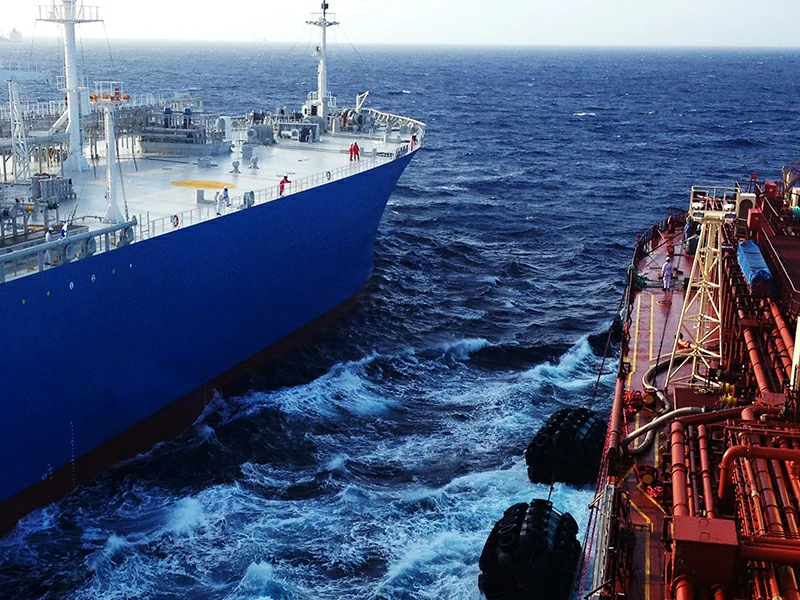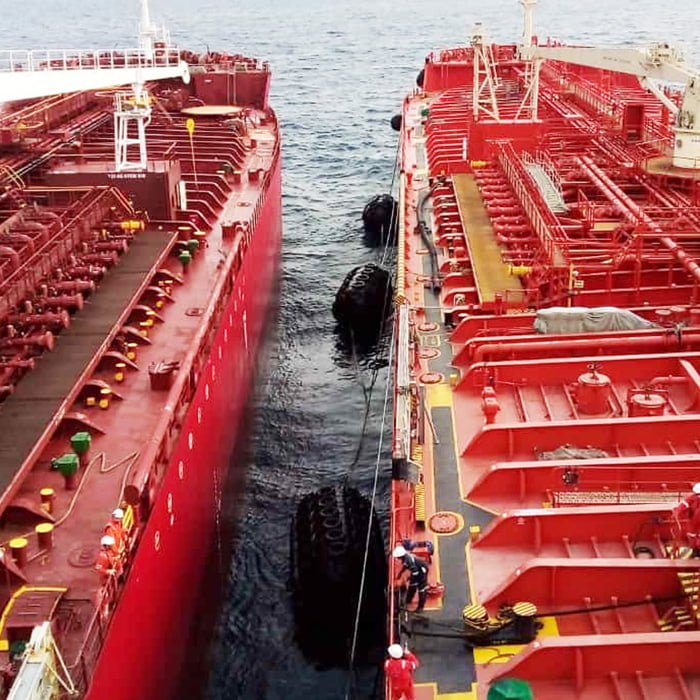Application areas of roller fenders
07/24/2025What’s the difference between mooring and docking?
07/25/2025Why ship to ship transfer?
What Is Ship-to-Ship Transfer (STS)?
Ship-to-ship transfer (STS) is the process of moving liquid cargo such as crude oil, LNG, LPG, or chemicals from one ship to another. It usually happens at sea or an anchorage, without the need to dock at a port. In most cases, a larger vessel (called the “mother ship” or delivering ship) transfers cargo to a smaller one (the receiving or daughter ship).

Why Do We Use Ship-to-Ship Transfers?
1. More Flexibility
STS doesn’t need a port berth. Ships can transfer cargo offshore, at anchor, or in designated STS zones. This saves time and avoids delays at busy ports.
2. Lower Costs
Ships skip port fees and reduce waiting time. That helps lower the total shipping cost and speeds up the whole logistics chain.
3. Commercial Advantage
Owners can change cargo ownership or destination mid-voyage. It’s a smart way to handle last-minute market changes or emergencies.
4. Emergency Use
STS can help lighten a vessel during accidents, breakdowns, or to prevent grounding.
5. Supports Clean Energy
As the shipping industry shifts toward green fuels like ammonia or CO₂ transport, STS offers a practical way to move cargo safely and flexibly.
How Does an STS Operation Work?
Step 1: Planning and Risk Assessment
STS operations must follow international guidelines like MARPOL Annex I Chapter 8 and OCIMF best practices. Before the transfer, both ships need to:
- Complete a full risk assessment.
- Appoint a qualified POAC (Person in Overall Advisory Control).
- Prepare an STS plan and emergency checklist.
Step 2: Equipment Check
Before operations begin, both crews confirm equipment compatibility. This includes fenders, hoses, mooring lines, and communication tools.
What Equipment Do You Need for STS?
Pneumatic Fenders
- These pneumatic rubber fenders absorb high energy and reduce impact between ships.
- They meet ISO 17357 standards and come in types like chain & tire net or sling type.
- Ships usually install 4–6 pneumatic fenders, depending on size and weather.

Foam-Filled Fenders
- These foam fenders don’t deflate and are easy to handle.
- They provide extra protection, especially in smaller contact areas.
Cargo Transfer Hoses
- Hoses must meet international safety standards (EN1765, BS1435, OCIMF).
- Each hose should have clear labels showing test pressure, antistatic protection, and expiry date.
- Crews inspect and pressure-test hoses regularly to avoid leaks or bursts.
Mooring Equipment
- High-quality ropes, winches, and fairleads are essential to hold ships steady.
- Mooring lines must be strong and elastic to handle wave motion.
Safety and Spill Gear
- Fire hoses, oil spill booms, and emergency kits must be onboard and ready to use.
- Regular safety drills are a must.
Communication Tools
- Radios, AIS (Automatic Identification System), and other GPS-based systems help both ships align properly.
- Crews stay in constant contact during the whole operation.
STS Operation – A Simple Walkthrough
1. Approach and Mooring
One ship keeps steady while the other approaches slowly. The crew places fenders between the hulls and secures the mooring lines to lock positions.
2. Hose Connection
Crews connect the cargo hose and vapor return line. Hoses must be grounded to prevent static discharge. They start with a slow flow to check for leaks.
3. Cargo Transfer
Once all checks are done, the transfer begins. Both teams monitor pressure, temperature, and flow rate closely to avoid issues.
4. Disconnection and Departure
After the cargo is fully transferred, the crew disconnects hoses, removes fenders and mooring lines, and clears the area. Ships then leave the site safely.

Following Safety Rules
Ship-to-ship transfers must meet strict rules from IMO, OCIMF, and local port authorities. Each operation should include:
- A written STS plan.
- A full equipment checklist.
- Records for inspections, training, and emergency drills.
All records should be saved for at least three years for audit or investigation if needed.

Final Thoughts: Equipment Makes STS Safe and Smooth
Ship-to-ship transfer is a practical, low-cost, and fast solution for moving liquid cargo. But without the right equipment, it can be risky. Here’s what really matters:
- Reliable fenders prevent damage between ships.
- Certified hoses ensure safe cargo flow.
- Mooring gear keeps vessels stable.
- Good communication helps avoid mistakes.
- Emergency tools prepare you for the worst.
If you get the gear and planning right, STS can be a safe, smart way to move cargo anywhere.
Frequently Asked Questions (FAQ)
1. What is a ship-to-ship transfer (STS)?
A ship-to-ship transfer is when one ship moves liquid cargo like oil, gas, or chemicals to another ship while both are at sea or anchored. It doesn’t require port docking.
2. Why do companies use STS operations?
They use STS to save time and money, avoid port congestion, adjust cargo destinations, or respond to emergencies. It’s also useful for transporting clean energy like ammonia or CO₂.
3. What equipment is needed for ship-to-ship transfers?
Key equipment includes pneumatic fenders, foam fenders, cargo hoses, mooring ropes, fire safety tools, and communication systems like radios or AIS. All equipment must meet safety standards.
4. Is STS transfer safe?
Yes, if done with the right planning, certified equipment, and trained crew. STS operations must follow IMO and OCIMF guidelines to ensure safety and prevent spills or accidents.
5. Where do STS operations usually take place?
They happen offshore, near ports, or in special STS zones. Locations are chosen for calm waters and safety clearance from other ships or structures.
